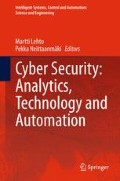Abstract
Like any other communication medium, cyber-space has been used for deception since its inception. Originally a medium that gave immediate global range to deceptive messages, it also provided a medium to contradict any deceptive message sent. Of course, messages are not necessarily true or false but convey an opinion about reality that the recipient accepts or does not. The main concern of managers of this information has been that the messages have not been corrupted by those with malevolent intent. Hence, at its simplest level the integrity of the message (in the information security sense) is the primary objective. With more complex messages the use of propaganda techniques that attempt to influence opinions are of concern. A medium such as the public Internet with its low cost of entry and ubiquitous access is ideal for this and, because of its multi-media and interactive format, gives a much better success rate that ‘conventional’ media. Cyber-space over the last few years has rapidly entered a new phase with almost universal use of mobile online devices that many individuals and organisations are becoming increasingly dependent on. In this environment two other developments have significant implications for the practice of deception which changes the degree to which it changes the relationship of machines, deception and humans. These new factors are: the development of neuroscience and its associated technologies, and networked robotics. These are examined in this chapter and the consequences for deception at the level of individuals and large groups are examined.
Access this chapter
Tax calculation will be finalised at checkout
Purchases are for personal use only
References
Barrat J (2013) Our final invention: artificial intelligence and the end of the human era. Thomas Dunne Books, New York
Bell JB, Whaley B (1991) Cheating and deception. Transaction Publishers, New Brunswick
Benjamin M (2013) Drone warfare: killing by remote control. Verso, London
Bennett M, Waltz E (2007) Counterdeception principles and applications for national security. Artech House, Norwood
Castells M (2007) Communication, power and counter-power in the network society. Int J Commun 1:238–266
Clark A (2014) Mindware: an introduction to the philosophy of cognitive science, 2nd edn. Oxford University Press, Oxford
Clark RM (2010) The technical collection of intelligence. CQ Press, Washington, DC
Cragin K, Gerwehr S (2005) Dissuading terror: strategic influence and the struggle against terrorism. RAND, Santa Monica
Fogg BJ (2003) Persuasive technology: using computers to change what we think and do. Morgan Kaufmann Publishers, San Francisco
Forbes P (2009) Dazzled and deceived: mimicry and camouflage. Yale University Press, New Haven
Gibson W (1984) Neuromancer. Harper Collins, London
Hill H, Johnston A (2007) The hollow-face illusion: object-specific knowledge, general assumptions or properties of the stimulus? Perception 36(2):199–223. doi:10.1068/p5523
Libicki MC (2007) Conquest in cyberspace: national security and information warfare. Cambridge University Press, New York
Lukes S (2005) Power: a radical view, 2nd edn. Palgrave MacMillan, Basingstoke
Machiavelli N (1532/1983) The prince (tran: Bull G). Penguin Books, London
Matrix (1999) Matrix, DVD, 131 minutes. Village Roadshow Films
Peacock M, Johnstone M (2013) Towards detection and control of civilian unmanned aerial vehicles. In: Valli C (ed) Proceedings of the 14th Australian information warfare conference (Perth, 2013). Edith Cowan University, Perth, pp 9–15
Rao RPN (2013) Brain-computer interfacing: an introduction. Cambridge University Press, New York
Satel S, Lilienfeld SO (2013) Brainwashed: the seductive appeal of mindless neuroscience. Basic Books, New York
Simons DJ, Chabris CF (1999) Gorillas in our midst: sustained inattentional blindness for dynamic events. Perception 28(9):1059–1074
Singer PW (2009) Wired for war: the robotics revolution and conflict in the 21st century. Penguin Books, New York
Stahl R (2010) Militainment Inc.: war, media and popular culture. Routledge, New York
Wesson K, Humphreys T (2013) Hacking drones. Sci Am 309(5):54–59
Willacy M (2013) Fukushima. MacMillan, Sydney
Author information
Authors and Affiliations
Corresponding author
Editor information
Editors and Affiliations
Rights and permissions
Copyright information
© 2015 Springer International Publishing Switzerland
About this chapter
Cite this chapter
Hutchinson, W. (2015). Deception in the Cyber-World. In: Lehto, M., Neittaanmäki, P. (eds) Cyber Security: Analytics, Technology and Automation. Intelligent Systems, Control and Automation: Science and Engineering, vol 78. Springer, Cham. https://doi.org/10.1007/978-3-319-18302-2_7
Download citation
DOI: https://doi.org/10.1007/978-3-319-18302-2_7
Published:
Publisher Name: Springer, Cham
Print ISBN: 978-3-319-18301-5
Online ISBN: 978-3-319-18302-2
eBook Packages: EngineeringEngineering (R0)

